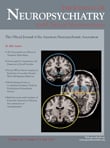Amisulpride-Induced Neuroleptic Malignant Syndrome
SIR: Neuroleptic malignant syndrome (NMS) is a rare, but potentially lethal complication of antipsychotic medication. The risk of developing NMS under atypical neuroleptics seems lower than under typicals. The use of atypical neuroleptics is increasing, so the incidence of NMS under these drugs may also increase.
Case Report
“Mr. K” was a 73-year-old man with a 5-year history of DSM-IV-TR bipolar disorder and no history of NMS. He had benign prostate hipertrophy and coronary atrery disease and was using medication for these diseases, too.
His medication had been changed from olanzapine to amisulpride. On the fourth day of his treatment, he developed clouding of conciousness and admitted to emergency service. He was stuporous, had increased muscle tone, diaphoresis, elevated body temperature (38.4°C), elevated blood pressure (140/100) and metabolic disturbance. First CK (creatinine kinase) value was found to be 1798 U/liter (49–397 U/liter).
Neuroleptic malignant syndrome was our diagnosis. Amisulpride was stopped immediately, fluid replacement and bromocriptine were started. Consciousness level improved immediately, metabolic status returned to normal within few days and CK levels decreased. No depressive and manic symptoms were seen and his treatment was arranged accordingly.
This case is diagnosed according to DSM-IV-TR criteria. The diagnosis is supported by the rapid improvement in the consciousness level and resolution of metabolic disturbance with discontinuation of amisulpride. We saw similar cases in our service, approximately one case every 2–3 months. Sometimes there is atypical presentation with DSM-IV diagnostic criteria not met but always following a change in antipsychotic medication.
Fever, muscle rigidity, and autonomic instability can be caused by neuroleptics in the absence of NMS. Catatonia has also been reported with neuroleptic use. Therefore maybe it is better to consider a dimensional approach and consider NMS in the spectrum concept. Presentation of syndrome with different drugs is different and it can be seen as a result of some antidepressants, lithium, dopamine-depleting drugs and cessation of dopaminergic drugs. We found two demonstrated cases with the use of amisulpiride. We want to report the case in order for us to collect data for upcoming classification of NMS risk by symptomatology, antipsychotic dosage and patient profile. This will allow clinicians to determine the possibility of NMS before even prescribing the drug.



